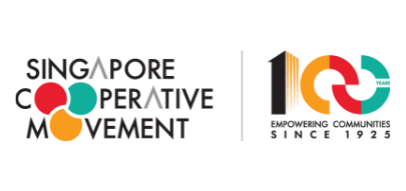- The Straits Settlement Co-operative Societies Ordinance was passed in 1924 and came into force in 1925.
- The first thrift and loan society, Singapore Government Servants’ Co-operative Thrift and Loan Society Ltd, was registered on 7 October 1925 with 32 members.
Featured
OUR COMMUNITY PROJECT
This project marks the 100-year legacy of the Singapore Co-operative Movement (SCM) with a limited-edition NTUC FairPrice tissue box. The artwork was created in collaboration with inmate artists from the Visual Arts Hub and supported by the Yellow Ribbon Project. In celebration of SG60, it portrays Singapore's rich history, highlighting the nation's progress over the years, as well as a glimpse into the promising future of Singapore. SCM has been and will continue to play a crucial role in strengthening Singapore's social compact through fostering inclusivity and unity within the community.
The inmate artists drew inspiration from Singapore’s resilience in overcoming challenges, portraying the people of Singapore as a valuable asset. The artwork celebrates the hard work, cooperation, and harmony that defined our community in the past, shaped our present and moved us towards a society that recognises each one’s potential for positive change.
The limited-edition tissue box is now available at some NTUC FairPrice outlets.
Visual Arts Hub (VAH) works in partnership with the Yellow Ribbon Fund (YRF) to nurture inmates’ artistic potential and train them to express themselves through art as a form of rehabilitation. This national charitable fund is dedicated solely to developing and implementing rehabilitation and reintegration programmes for inmates, ex-offenders, and their families.

Our History


1925


1925 - 1940
- More people began to see the usefulness of the co-operative concept of self-help and mutual assistance.
- 43 thrift and loan societies were formed to cater to the needs of civil servants, teachers, custom officers, and those in private sectors.
- The Singapore Urban Co-operative Union was established on 16 November 1933 as the central organisation to enable co-ordination and collaboration of the growing number of societies.


1950 - 1990
- Singapore Urban Co-operative Union Ltd was renamed Singapore Co-operative Union Ltd in 1954 and later, Singapore National Co-operative Union Ltd in 1972.
- SNCF was formed on 18 September 1980 as the apex body of the Singapore Co-operative Movement.
- The Singapore National Co-operative Union assumed its new role as Singapore Amalgamated Services Co-operative Organisation Ltd in 1982 and became an affiliate of SNCF.
About Our Logo

Our centennial logo encapsulates a century of collaboration, growth, and progress. The numeral “1” and upward arrow symbolise a forward momentum, while the two interconnected circles forming “100” reflect partnership and solidarity. It is divided into three vibrant segments - red representing leadership, orange for unity, and green for growth.

Our tagline highlights how the Singapore Co-operative Movement has been empowering communities, championing social causes, and fostering a strong and resilient movement since 1925.
know our co-ops
Credit Co-operatives, or Thrift and loan societies, are co-operatives that encourage thrift by accepting deposits from members and assisting members with loans on reasonable terms. A thrift and loan society is an association of persons who are grappling with the same economic challenges and who join together on a basis of equal rights and obligations through a democratically controlled enterprise.
Majority of the credit co-operatives are work-based where employees of the organisation are recruited as members of the co-operative. As a form of staff benefits, organizations offer check-off system, which enable deductions of staff monthly salaries for contributions towards their subscription accounts and loan repayments with their co-operatives.
Today, credit co-operatives play an important role in upgrading the economic and social status of their members.
Objectives of the Credit Co-operatives
∙ Prevent permanent indebtedness of its members by enabling them to obtain loans on reasonable terms. Different types of loans are offered to members: personal loan, education loan, housing loan and travel loan;
∙ Encourage thrift, they offer savings and fixed deposit schemes to members at competitive interest rates
∙ Assist members to reduce the cost of living and improve their economic needs.
View the list of Credit Co-operatives here.
These co-ops, formed by the National Trades Union Congress (NTUC), strive to harness its gamut of social enterprises to do good and meet the pressing social needs in areas like health and eldercare, childcare, daily essentials, cooked food and financial services. They are formed by the Labour Movement with the primary purpose of serving workers and their families.
View the list of NTUC Co-operatives here.
This Sector consists of co-operatives providing a wide range of services to their members. The types of services provided include environmental services, security, travel, aged care, management corporation and welfare. While business driven, service co-ops are anchored in their social mission to help Singaporeans and residents moderate the cost of living in Singapore.
View the list of Service Co-operatives here.
Campus co-ops operate on the campuses of schools, colleges, polytechnics, and universities. Through mentorships by teachers, campus co-ops offer students first-hand experience at running a social enterprise on economic and co-operative principles.
Open to students, teachers, lecturers and staff of campuses based in Singapore, these co-ops provide a variety of services to their members such as the sale of books, stationery, IT services, sports goods, canteen services, travel and more.
Objectives of the Campus Co-operatives
- Promote the economic interests of its members.
- Encourage thrift, co-operation, self-help and mutual assistance among its members.
- Promote and popularise the buying and selling of educational materials, consumer goods and services on a co-operative basis.
- Establish and operate such co-operative schemes, ventures or projects subject to the approval of the registrar.
- Develop entrepreneurial skills of members through exposure to various types of co-operative activities.
- Inculcate in members self-discipline, self-reliance, responsibility and accountability and to provide opportunities for total character development.
Campus Co-operative as a co-curricular activity
The educational values and experience gained by the students are recognised by the Ministry of Education. The Ministry has in fact endorsed the students' participation in campus co-op as a Co-Curricular Activity (CCA). Students who are involved in this activity can qualify for bonus points in the CCA Grading Scheme. The Education Ministry has also left the formation of such co-operatives to schools and colleges.
View the list of Campus Co-operatives here.





















